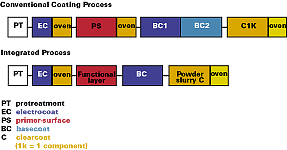BASF Coatings’ Integrated Process, a system designed to deliver economic and environmental advantages in the application of automotive OEM coatings, has received the PACE award recognizing innovations in automotive technologies. The award, sponsored by Automotive News and Cap Gemini Ernst & Young, cited BASF’s development of a process that eliminates the high-temperature bake step following application of a primer to automotive bodies.
Meanwhile, BASF says its R&D experts are exploring ways to achieve another key objective in the quest for the ultimate performance and appearance properties in automotive-coatings advances: the development of finishes that offer significantly improved scratch resistance. These efforts are focused on new chemistries and materials, including highly crosslinked polymer networks, the use of glass-ceramic particles, and ultraviolet-curing methods.
Integrated Process Involves ‘Wet-on-Wet’ Coating System
BASF says its Integrated Process system for automotive OEM coatings application was developed to find a more economical and ecological means to paint cars. The process improves efficiency by using less energy and paint, while requiring no major retooling to the application equipment, the company says. The process also reduces air-pollution emissions, since the coatings used are waterborne. These benefits come at no cost in terms of quality or the vehicle’s finished appearance, BASF says.As opposed to conventional application methods, the Integrated Process is a “wet-on-wet-on-wet” application system that uses waterborne coatings, including a recently developed powder slurry clearcoat. The slurry consists of a powder coating finely dispersed in water by means of a specialized technology, which is then applied electrostatically.
In the application process, auto bodies are immersed in an anticorrosion, heavy metal-free dip coating. The bodies are then coated with two waterborne basecoat layers, the first of which assumes the function of a primer-surfacer. The final coat is a clearcoat applied by the powder slurry process. To assure a perfect color match, plastic components are affixed to the body before applying the topcoat and are coated at the same time.
The process was developed and commercialized for the Mercedes-Benz A Class model manufactured at the automaker’s Rastatt, Germany, assembly plant.
“Receiving the PACE Award is a tremendous honor for BASF, and it will certainly fuel our drive to continuously bring more value-added innovations to our customers,” said Raimar Jahn, group vice president, BASF Automotive OEM Coatings, who accepted the award along with BASF Coatings and Colorants Division President Frank E. McKulka. Jahn said the Integrated Process “is the most significant representation of our ECO2(SM) product development and technical consultation initiative, which emphasizes advantages in ecology and economy.”
Jahn said the process “offers a competitive edge and successfully proves that ecology and economy do not necessarily compete against each other.”
The Integrated Process has earned a number of other accolades for BASF, including the “Aktion Muensterland” Innovation Award and the BASF AG Innovation Award. The process also was a finalist in the DaimlerChrysler internal Innovation Award, the European Better Environment Award for Industry; Environmental Protection Award of the Federation of German Industries; and the Innovation Award in Cannes.

Current R&D Efforts Focus on Ways to Boost Coating Scratch Resistance
In a preview of emerging automotive-coatings technologies, BASF Coatings says it is focusing considerable R&D efforts on highly scratch-resistant clearcoat finishes that might even possess “self-healing powers” thanks to molecules that are “programmed” to repair at least minor damage themselves.“The more tightly the (coating) network is knit, the more resistant paint finishes become to mechanical damage,” says Klaus Dieter Plitzko, head of BASF’s Coatings Research unit. Thus, research is focused on new coating components that offer increased numbers of linking points to form an exceptionally “close-meshed” network.
While declining to provide specific details on its research in this area, BASF says its work in the development of highly scratch-resistant finishes is focused on three general areas:
- “Suntan lotion” for coatings. Research here emphasizes formulation of the optimal light stabilizer, consisting of UV absorbers and free-radical scavengers.
- New, highly resistant materials. Another approach in the quest for ultimate scratch resistance is the use of materials similar to the “Ceran” cooking surface, which consists of a special, rolled glass-ceramic. The result is a surface that remains unblemished even when subjected to abrasive cleaning agents. The formulating key is compensating for the brittleness of the glass and attaining the elasticity necessary for automotive applications. This has already been achieved in the laboratory, the company says.
- UV curing. While this technology is well established in the finishing of flat surfaces such as desktops and flooring, the challenge facing automotive-body coating is attaining coating cure on complex, three-dimensional structures. In addition, the technology demands the development of “intelligent” light stabilizers that do not interfere with the UV-light cure mechanism but still protect the finish from solar degradation following cure.
Another potential tool in the bid to boost scratch resistance is the incorporation of so-called “nanoparticles” in the paint film. These tiny balls, only a few billionths of a millimeter in diameter, can possess the same chemical makeup as glass and provide a high degree of scratch resistance. But the challenges here include the need for high production volumes and a completely identical structure among the particles, says Plitzko. And the coatings manufacturer must develop ways to optimally disperse the particles in the paint and ensure long-term stability, he says.


Report Abusive Comment